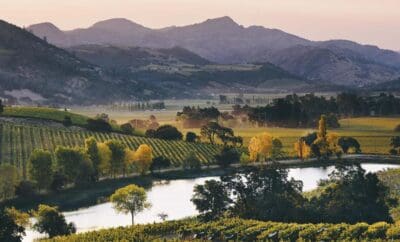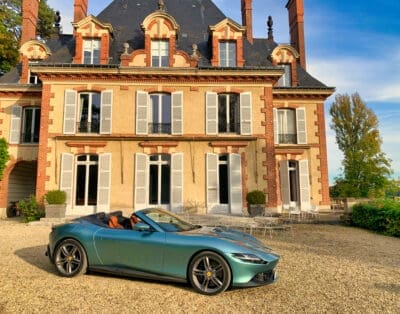Exploring Insignia – Joseph Phelps’ Flagship Wine
In the heart of Napa Valley lies Joseph Phelps Vineyards, a winery that I fell in love with during a visit in 2004, while conducting research for a book on North American wines. Unlike many other estates, Joseph Phelps had a human touch, an absence of corporate sterility that left a lasting impression. Here, the emphasis was on genuine care and the people who worked there. It was highly professional but reminded more of renowned Australian wine estates, where the owners would be just as happy enjoying a beer in the pub with the vineyard workers, as in the boardroom. Established in 1973 by Joseph Phelps, this estate consistently produces wines that strive to show the terroir of the region whilst using sustainable practices. The focus on regenerative farming underscores a commitment to biodiversity, with the ethos that nurturing the soil results in rewards.Coming from modest beginnings, Phelps faced challenges before moving to Colorado, where his journey took him through Colorado State University, the Navy, and ultimately the family construction business, Hensel Phelps Construction Company. His vision helped to transform it into one of the USA’s most successful construction companies within a decade. During this time, he grew his wealth which allowed him to indulge in his passion for world-class wines and fine dining. Consumed by wine, he even took to trying to make his own, having grapes sent to him from the Napa Valley to make homemade wine with. I wonder how successful that was?Operating across multiple states, Hensel Phelps was commissioned to build the Souverain winery in Napa. Phelps, truly inspired by this project, and ignited with passion, set out to fulfil his dream to build and own one of the world’s great wine estates. He acquired a 600-acre former cattle ranch in St. Helena and on March 1, 1973, planted 100 acres with Cabernet, but also seemingly random varietals such as Riesling and Gewurztraminer.On a mission to create wines that could rival the world’s best, he eventually focused on selecting varieties suited to the Napa climate, with a particular focus on Cabernet Sauvignon, Merlot, and Syrah. Keen to learn every facet of the industry, he regularly consulted leading winemakers and learned through experimentation, even replanting entire vineyards if they fell short of his expectations.In many ways, he was a trailblazer, and along with the likes of Robert Mondavi, played a pivotal role in elevating Napa to become the world-renowned wine-growing region it is today. Worth noting is that he was the first to legally release a Syrah in 1974 when the variety was relatively unknown outside the Rhone Valley.As a keen lover of Bordeaux and owner of a rather serious collection of 1st Growths, he had a natural passion for blends. This inspired him to introduce Insignia to the world in 1978, a Bordeaux-style blend that quickly became a benchmark in the region.Today, the estate sprawls over 512 acres, featuring 11 prime vineyards strategically located in sub-appellations like Oakville and Yountville. This deliberate placement allows winemakers to harness diverse microclimates and soil types, shaping the grapes’ character. The Backus Vineyard, a crown jewel in the Oakville AVA, consistently yields exceptional Cabernet Sauvignon grapes, a significant contributor to Insignia.Like any luxury item, crafting them takes time, precision and ultimately passion. Phelps’ quest never to rest on his laurels and always question what was next has driven the estate to what it is today, having just celebrated its 50th anniversary. Innovation and best practices are evident throughout, right down to micro-picking individual bunches of grapes, waiting until each hits its perfect ripeness. His legacy is more than just the wine. It’s about a man who dared to dream, to blend passion with business, and in doing so, influence winemaking across America. Phelps’s vision was not merely to produce incredible wines, but to foster a culture where excellence and sustainability were at its core. His approach to winemaking was holistic, considering everything from the health of the vineyards to the well-being of his employees.Unlike many of his contemporaries, he eschewed the traditional approach of simply selling wines. He created an experience for his customers, offering tastings and tours. His focus on the experience helped Napa become known as one of the great wine tourism destinations. The winery became a centre for cultural and social events, drawing wine lovers from around the world. Beyond the wine tastings, art exhibitions, or community gatherings, Phelps believed in the power of wine to bring people together. At heart, he was a community man, with his vision extending beyond viticulture. He contributed to the community by offering equity to early employees and, dissatisfied with the local produce, opened a deli to provide access for everyone to the quality of food and produce he longed for. Late last year I attended a wonderful lunch at Beast in London, alongside estate director David Pearson and Elizabeth Phelps Neuman, the oldest grandchild of founder Joseph Phelps.where we enjoyed several wines from the estate, including multiple vintages of Insignia, going back to 2001, to demonstrate the elegance and long-term maturation capabilities of this now iconic wine. These were matched with steak from the Lake District and Wagyu which complemented each other perfectly. We started with the 2021 Cabernet Sauvignon that showed notes of blackcurrant, mint, tobacco, and pencil shavings, along with elegance. Moving onto the 2019 Insignia, it was rich, and full, whilst reflecting its youthfulness. With supple tannins, this promises a rewarding evolution over time. The 2014 boasted a full nose refined with cherries, floral notes, and even a hint of mocha. Velvety tannins are seamlessly integrated into the wine.Meanwhile, the 2010, exhibited chocolate and cassis with vanilla giving it a wonderful depth. The secondary flavours were just beginning to show. A classic vintage, the Insignia 2001 brimmed with fruit offering delicate nuances of damsons, tobacco, and brambles. It showcased just how well these wines can age, which I am very grateful for, as I have a bottle of this in my collection!josephphelps.com









